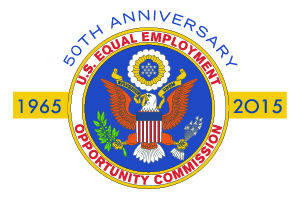![]()
When most people hear about workplace harassment, it’s likely to be sexual harassment because that’s traditionally been the most common and publicized form.
However, harassment is much broader than that of a purely sexual nature. In fact, harassment may take many forms of which not everyone is aware.
Under federal laws prohibiting employment discrimination, harassment can be based upon race, color, religion, age, disability, national origin and even genetic information — in addition to sex.
Complaints on the Rise
Harassment complaints by federal workers against their agencies have increased over the years, according to data from the U.S. Equal Employment Opportunity Commission (EEOC).
Further, federal sector complaint statistics may only represent the proverbial tip-of-the-iceberg. That’s because many employees might be fearful of speaking out against harassment or reporting unlawful behavior via the EEO complaint process, which the EEOC is seeking to improve.
Some federal employees who are victimized by harassment may suffer in silence due to fear of retaliation by management and/or co-workers.
Meanwhile, the harasser may continue to violate the law unabated and target other employees if not initially stopped.
Key Elements of Anti-Harassment Policy
This week, the EEOC’s Office of Federal Operations (OFO) issued the latest edition of its quarterly “Digest of EEO Law” which contains a special article, The Law of Harassment: Assisting Agencies in Developing Effective Anti-Harassment Policies.
“The article on harassment contains an overview of the applicable statutes as well as recent case law,” says OFO Director Carlton M. Hadden. “It should provide helpful information to our stakeholders when they are drafting anti-harassment policies.”
The article points out, for example, that “claims of non-sexual harassment have ranked first in claims filed under the federal sector EEO process since 1994.”
“The percentage of federal sector complaints alleging non-sexual harassment has increased over the past 10 years.”
Therefore, “Ensuring that federal agencies maintain effective internal policies and put in place procedures to deal with harassment is critical in furthering the government’s role as a model employer” the EEOC explains.
So how should federal agencies formulate and incorporate strong anti-harassment policies into their broader efforts to prevent all forms of workplace discrimination?
 The EEOC lists the following six key elements to include in any effective anti-harassment policy:
The EEOC lists the following six key elements to include in any effective anti-harassment policy:
- A clear explanation of prohibited conduct;
- Assurance that employees who make claims of harassment or provide information related to such claims will be protected against retaliation;
- A clearly described complaint process that provides accessible avenues for complainants;
- Assurance that the employer will protect the confidentiality of the individuals bringing harassment claims, to the extent possible;
- A complaint process that provides a prompt, thorough, and impartial investigation; and
- Assurance that the employer will take immediate and appropriate corrective action when it determines that harassment has occurred.
Proactive Prevention is Best Medicine
EEOC stresses that, “Agencies should ensure that their supervisors and managers receive periodic training so that they understand their responsibilities under the agencies’ anti-harassment policy and complaint procedure.”
Moreover, “Such training should explain the types of conduct that violate the agency’s anti-harassment policy; the seriousness of the policy; the responsibilities of supervisors and managers when they learn of alleged harassment; and the prohibition against retaliation,” says the EEOC
Further, “Agencies should also train employees about the anti-harassment policy and complaint procedures, and should educate employees about the types of conduct that constitute harassment under the anti-discrimination laws.”
Executive management and leadership of federal agencies should be mindful that harassment results in lower employee performance and productivity, less employee engagement, decreased morale and job satisfaction, and increased absenteeism – all of which hinder mission-related strategic goals and results.
In essence, workplace harassment is like a cancer that will grow and spread if not quickly and appropriately addressed.
That’s why proactive prevention is the best medicine to stop harassment before it starts – through effective policy implementation, clear communication, as well as training and education.
It’s important to remember that all federal employees have statutory rights protecting them from harassment. Also, all federal agencies have EEO offices and counselors to handle workplace disputes.
And, last but not least, it’s important to remember that no manager or supervisor is above the law – period!
David B. Grinberg is part of the GovLoop Featured Blogger program, where we feature blog posts by government voices from all across the country (and world!). To see more Featured Blogger posts, click here.





I think it important to recognize that while some of what people report as harassment IS of the targetted variety (i.e., bullying of various kinds), and some IS of the sexual kind, there is much – sexual and otherwise – that is not deliberately directed at *identified* individuals, but which can still leave people feeling victimized, marginalized, and even traumatized.
For instance, employee X in one agency gets a chewing out over the phone from client Y in another agency because that second party is under pressure to have something ready and they need it provided by X yesterday. Or someone shows up to a taxation office or passport office or other office where members of the public have to wait to be served by a federal employee. After 90 minutes of rocking the stroller back and forth to quiet the toddler down, their number finally gets called and they approach the service wicket in none too friendly a mood. Or a VA hospital nurse or orderly may get an earful and wrestling match from a dementing or hallucinating vet.
All are experiences of harassment by the person on the receiving end, yet none are really directed to them *personally*. They just happen to be the employee doing that job and taking the brunt of the other person’s wrath and impatience. The person at the service counter may never run into that same impatient client ever again…BUT they may experience similar episodes from other clients, repeatedly.
The question is “What can the employer do in such cases?”. Most interventions intended to reduce harassment in the workplace have to do with relationships between co-workers, or supervisors and subordinates. Where the source comes from outside one’s immediate corporate sphere, things get a little trickier. I would imagine in some instances, there is an association between the experience of harassment and the resources available. Too few staff at the service wickets, and the lineups can get testy. Some of it can also stem from changes to process, or unfathomable forms/protocols that easily generate frustration in clients, or simply not explaining things well to clients and fostering unrealistic expectations. My sense is that the connection between business decisions, and employee experience of harassment, tends not to be noticed, many a time, or factored into HR’s set of objectives for the coming year.
This is all to say that, as helpful as the sorts of policies, values, and interventions you note can be, reduction and prevention of workplace harassment is not simply a case of employees learning to be civil and respectful with/of each other. The *experience* of harassment can come from a variety of quarters, which can require a much deeper insight into the relationship between how an agency conducts business, and how people behave under those circumstances.
There are finite limits to human cooperation, and we need to be mindful of them in our organizational design and planning, if we want the best performance, and the best behaviour, from people.
Thanks so much for the exemplary feedback, Professor Hammer. It’s great to hear from you again. Your words of wisdom are most appreciated!
No one should tolerate workplace harassment, it is understood at not just the government offices but at any workplace; however, there are chronic cases of employees using this as a get out of jail card, meaning employees that are performing poorly, basically cheating the hard working and tax paying American people, files a complaint because they are being asked to work, for what they have signed up for, and of course once they file no one dare to tell them to get back to work. How do you handle cases like that?
Robert, thank you for taking the time to share your important insights. I would note that many allegations of harassment and discrimination in the federal workplace never become formal EEO complaints because they are resolved through the pre-complaint counseling process via an agency’s EEO office. One effective tool for resolving workplace disputes before they become formal complaints is Alternative Dispute Resolution techniques such a mediation. I would also point out that frivolous allegations are dismissed outright. As you note, poor performance alone should never be used as an excuse to file an EEO complaint — and such potential cases are usually dismissed at the outset of the EEO process.
The Civil Service Reform Act (CSRA) of 1978 states that Federal Employees are to be protected from Arbitrary Actions, a catch all term for harassment, bullying an other capricious act for reprisal. For too many years discrimination and more recently Whistleblowing has overshadowed the CSRA law. I found it after 3 years of research I found it and am spreading the word that harassment for Any Reason if against the law, so those in management and Human Resources and even attorneys I consulted who told me harassment wasn’t against the law unless you could prove discrimination or Whistleblowing, you are wrong and I have contacted Congress and OPM about this and will push till they stop the unlawful act of discrimination and those that allow and assist in it. Please pass the word.
I was told by several attorneys, including Andrew Perlmutter of Passman & Kaplan Law Firm, HR Specialists at the Census Bureau, including the Division Chief of HR and a Union Representative that harassment is not unlawful unless you can prove discrimination or Whistleblowing. THEY ARE WRONG. I could not believe that Congress protected Federal Employees from discrimination and Whistleblowing and leave all others as fair game for those who would harass. After 3 years of research I found the Civil Service Reform Act of 1978 (CSRA) which created the Office Personnel Management (OPM), the Merit Services Protection Board (MSPB), and the Office of Special Counsel (OSC) to “Protect Federal Employes from arbitrary abuse”, a catch all term for harassment, bullying or any other capricious act out of reprisal. I believe CSRA was forgotten after the Whistleblower Protection Act of 1989 (WPA) was passed. The CSRA was amended to give the MSPB authority to adjudicate and OSC to investigate claims of harassment due to Whistleblowing and all the precedence set by those cases and those for discrimination for harassment overshadowed the CSRA’s arbitrary abuse. I have contacted the Federal Employees Oversight Committees and Subcommittees with my findings and will take my documentation proving I was a victim of harassment for many years, but denied protection because everyone believe it wasn’t against the law. It is and I am trying to get the information out so please pass it on, the Civil Service Reform Act of 1978 is the law,, it is time Congress ensures the law if followed by the agencies that were created to do so. As I told the Director of the Census Bureau, even if harassment were against the law, which it is not, it is still wrong and should not be allowed. I recommend to those who have been subjected to harassment, document and report to your agency before you approach an attorney. I believe in the near future agencies may be willing to settle, so save your money from the attorneys. I just sent the info to Congress on Jun 23, 2015, so it may take a little time for OPM and agencies to get on board, but I am working on it. Also, I don’t see a time limit on the reporting.